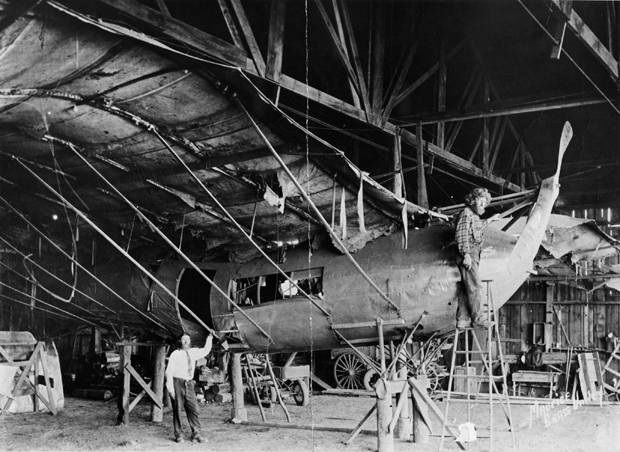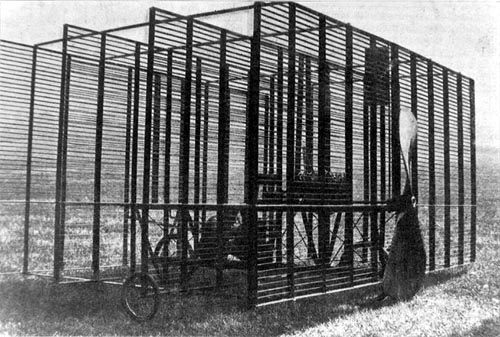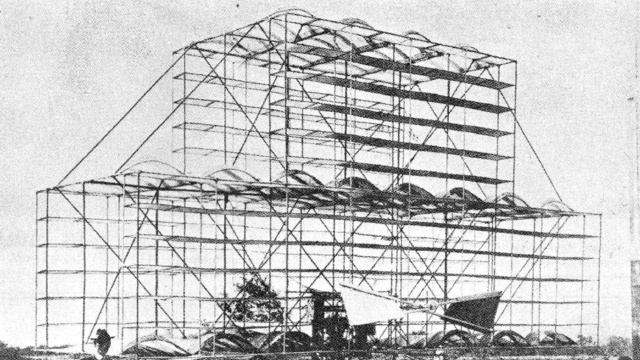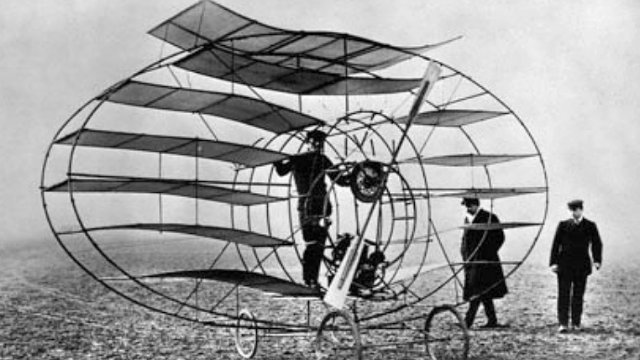Most of the earliest aircraft look nothing like modern day aircraft. However, some didn't even look like early day aircraft. In our collection are the papers of A.P. Kieth, a man from New England who got rich in the California Gold Rush and used his new found wealth to create a flying machine. He was able to get a patent for invention in 1870, which was quite different from the other flying concepts of the time, which mostly consisted of flapping wing gliders.

This image of the A.P. Kieth flying machine model is the oldest in our collection. It is a glass negative circa 1869. More images from this collection can be found here.
Shortly after the 1903 Wright Brothers flight, another pair of brothers pursued aviation immoratily near Grass Valley, California. In 1907, Lyman Gilmore and his brother, Charles, built a very large airplane that would have been able to carry 8 passengers and would have been decades ahead of its time if it took off. However, it never came close to taking off.

The Gilmore passenger plane under construction. Lyman Gilmore also claimed to have built an aircraft that flew a year before the Wright Brothers....however there were no witnesses to verify this claim.
If one wing is good, 200 must be better, or so reasoned Englishman Horatio Philips, who built a series of aircraft that had small wings that resemebled Venitian Blinds. Although his airplanes were not very successful, his experiments did prove helpful in advancing airfoil design.
The San Diego Air and Space Museum has a model of the Philip's 1904 plane with 21 airfoils.

500 feet is how long Philip's 1907 model flew. That is 2.5 feet for everyone of its 200 airfoils!
When it comes to wings, Alexander Graham Bell called and told Philips to hold his Airfoil. Bell, yes that Bell of telephone fame, was a member of the Aerial Experiment Association along with others interested in aviation (including Glenn Curtiss). The AEA produced a series of aircraft and one of the AEA's designs, the Cygnet I, had a wing that was made up of 3,393 tetrahedral cells.

Unlike the Cygnet I which was able to achieve flight by being pulled by a motorboat, the AEA's Cygnet II, never got airborne.
Yes, among the early pioneers, the idea of multiwing airplanes really took off. A multiplane is generally defined as an airplane with 5 or more wings. It is not an understatement to say that there were multiple multiplanes! Here is just a few of them.

1908 Roshon multiplane had 13 wings. With such a lucky number, it is a wonder it never flew!

The 1908 Marquis d'Equevilly was a French job, where the pilot had the pleasure of standing during flight (which it never accomplished).

The Zerber Multiplane featured 6 staggered wings, which is 6 more than the number of flights it made.

Breaking news: The large Johns Multiplane actually flew. Kind of...it was too unwidley to control for much longer than a few feet in the air.
Some didn't needn't that many wings...maybe just a circle would suffice, take for example the Lee-Richards Flying Saucer Annular Monoplane built in 1913, which can be considered a real flying saucer. Although it did take off and have successful flight, the idea of an annular airplane never really "took off."

This version of the Lee-Richards Annular Monoplane was one of several models.
With the onset of the First World War, there were many unsual aircraft as the belligerents strove to make the most efficient killing machine. However, one aircraft represents the race for function over form better than the rest, the Royal Aircraft Factory B.E.9. This aircraft put a small gunners platform in front of the propeller in a quest to avoid bullets hitting the props.

The gunner in B.E.9 had to be very careful not to move his head back too far if he didn't want to lose it.
We will end the first 2 decades of flight with the largest ariplane ever made in that period, the Siemens-Schuckert R.VIII, one of the series of Riesenflugzeug, giant airplanes built in Germany.

Those aren't ants, those are people! Unfortunatley, the R.VIII never flew and was destroyed during ground tests.
2001 Pan American Plaza, San Diego, CA
Phone: 619.234.8291
Información En Español
Contact Us
We would like to thank all our sponsors who help us make a difference. Click here to view all who help us.

The San Diego Air & Space Museum is a 501(c)(3) non-profit organization. Federal Tax ID Number 95-2253027.
